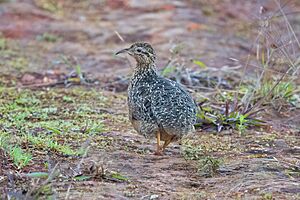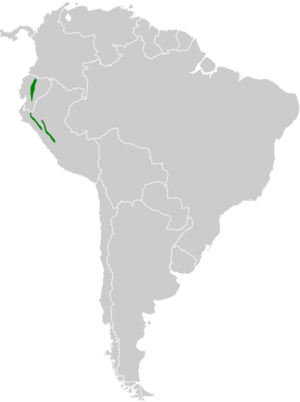Curve-billed tinamou facts for kids
Quick facts for kids Curve-billed tinamou |
|
|---|---|
 |
|
| Conservation status | |
| Scientific classification | |
| Genus: |
Nothoprocta
|
| Species: |
curvirostris
|
| Subspecies | |
|
N. c. curvirostris Sclater, PL & Salvin, 1873 |
|
 |
|
The curve-billed tinamou (Nothoprocta curvirostris) is a special type of bird. It lives in the high mountains of South America, especially in the Andes. You can often find it in grassy areas and places with lots of shrubs.
Contents
About Tinamous
All tinamous belong to the bird family called Tinamidae. They are also part of a larger group of birds known as ratites. Other ratites include ostriches and emus.
Unlike most other ratites, tinamous can actually fly! However, they are not very strong fliers. Scientists believe that all ratites came from birds that could fly a long, long time ago. Tinamous are the closest living relatives to these ancient flying birds.
Different Types of Curve-billed Tinamous
The curve-billed tinamou has two main types, called subspecies. They live in different parts of the Andes:
- N. c. curvirostris lives in the central and southern parts of Ecuador. It also lives in northern Peru, especially in the Cordillera del Condor mountains.
- N. c. peruviana is found in northern and central Peru. This includes areas like eastern Piura, Cajamarca, Amazonas, and other regions.
What They Look Like
The curve-billed tinamou is about 28 cm (11 in) long. Its back is dark brown with white stripes and black spots. Its chest is a reddish-brown color with white spots. The belly is a light yellowish-brown. Its head is black, but the sides of its head, throat, and front of its neck are white. Finally, its legs are brown.
How They Live
Just like other tinamous, the curve-billed tinamou mostly eats fruit. They find fruit on the ground or on small bushes. They also enjoy eating tiny invertebrates (like insects), flower buds, soft leaves, seeds, and roots.
When it's time for eggs, the male tinamou takes care of them. He might incubate eggs from up to four different females! After the chicks hatch, he raises them until they are ready to be on their own. This usually takes about two to three weeks. Their nest is built on the ground, often hidden in thick bushes or between large tree roots.
Where They Live
This tinamou lives in the Andes mountains. You can find it from central and southern Colombia, through Ecuador, and into northern and central Peru. They prefer to live in grasslands. These grasslands are usually very high up, between 2,800 to 3,700 m (9,200–12,100 ft) above sea level. They also live in high-altitude shrubland and pastures.
Keeping Them Safe
The IUCN (International Union for Conservation of Nature) keeps track of how many animals are left in the wild. They list the curve-billed tinamou as "Least Concern". This means there are still many of them, and they are not currently in danger of disappearing. Their habitat covers a large area, about 30,000 km2 (12,000 sq mi).


